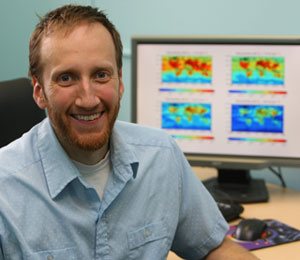 |
| Jeff Pierce studies atmospheric aerosols. (Nick Pearce Photo) |
When the Earth decides to remind us of its power there's little we can do but get out of the way. The eruption of the Eyjafjallajökull volcano in Iceland was a stark reminder there are events over which we, as puny humans, have little-to-no control.
Even so, research can help us to anticipate what happens next. In the case of the volcano, for example, scientists can predict the path of airborne pollutants, such as volcanic ash, volcanic gases and volcanic smog (the tiny particles formed when gas reacts with moisture, oxygen and sunlight). Other particulates occurring naturally originate from dust storms, forest and grassland fires and sea spray.
But Mother Nature isn’t the only one adding to a climactic mix that could harm our atmosphere and health. Humans do their part too. Human activities such as the burning of fossil fuels in vehicles, power plants and various industrial processes also generate significant amount of particle emissions.
Dalhousie researcher Jeff Pierce, assistant professor in Physics and Atmospheric Science, recently received $123,889 from the Canada Foundation for Innovation to study atmospheric aerosols that directly affect both human health and climate.
Plume model
“Atmospheric aerosols and their concentrations have changed greatly in recent years,” he says. “Those changes due to human activity remain the most ambivalent factor contributing to recent climate change and we need to know exactly how these emissions will affect the air that people breathe.”
When trying to measure aerosol composition, there are considerable challenges in trying to get the necessary resolution when modelling. To better understand the process Dr. Pierce is developing a new model system that provides improved measurement. Instead of measuring large, difficult-to-control areas, Dr. Pierce will measure the representation of aerosols that occur near original sources, such as power plants, before they become mixed with ambient air.
“It's difficult to 'show' this process with the high resolution we need,” notes Dr. Pierce. “We have developed or are developing a model of the source plume that will predict the number, size and composition of aerosols that mix with the ambient air, and these values may be used as inputs for regional and global models. We will use the plume model to test thousands of cases where the source conditions and the ambient chemical and meteorological conditions are varied.”
Once these sources have been adequately measured, Dr. Pierce will then be able to plug into global and regional models to figure out how these sources affect climate.
The ultimate goal is to better predict atmospheric aerosols and determine how emissions affect the air we breathe. “It would help determine if the addition of emissions control strategies to power plants are an overall benefit to climate and health,” says Dr. Pierce. “This is because we are developing a more complete picture of the chemistry and physics that shape the pollution as it moves away from the stack.”
Learning from Eyjafjallajökull
So what does all this have to do with the hard to pronounce Eyjafjallajökull? Well, making broad-based climate predictions is limited by our understanding of aerosols. Research to date allowed scientists to predict—to some degree—the path of the ash cloud that the volcano spewed into the atmosphere, and that knowledge will only increase with further study.
With Eyjafjallajökull, the aerosols rose into the troposphere (where planes fly) and dissipated within a week or two. But a more powerful blast could rocket aerosols into the stratosphere, affecting climate for up to a year. Needless to say, more research into the affects of aerosols will go a long way to help prepare for future “events”.
“I'm biased,” Dr. Pierce sums up. “But understanding the physics and chemistry of the atmosphere and the ecosystem is huge. This kind of understanding is how we can make good decisions in the future.”
